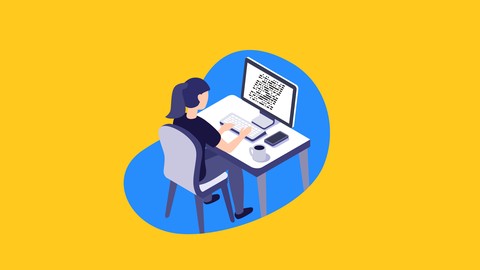
Python for Everyday Life
Python for Everyday Life, available at $19.99, has an average rating of 3.45, with 84 lectures, based on 14 reviews, and has 133 subscribers.
You will learn about Automate the execution of lots of common everyday life tasks using Python Write Python code proficiently in a structured fashion Identify the boundaries of a coding problem and spot the best libraries to solve it Design and Implement a wide range of applications from simple stand-alone one-liner scripts to complex web applications depending on external services Manipulate efficiently and visualize data as a way to make informed decisions This course is ideal for individuals who are This course is for Python developers and users from all spheres of life who would want to get well versed with Python and use it to put their life on autopilot! It is particularly useful for This course is for Python developers and users from all spheres of life who would want to get well versed with Python and use it to put their life on autopilot!.
Enroll now: Python for Everyday Life
Summary
Title: Python for Everyday Life
Price: $19.99
Average Rating: 3.45
Number of Lectures: 84
Number of Published Lectures: 84
Number of Curriculum Items: 84
Number of Published Curriculum Objects: 84
Original Price: $109.99
Quality Status: approved
Status: Live
What You Will Learn
- Automate the execution of lots of common everyday life tasks using Python
- Write Python code proficiently in a structured fashion
- Identify the boundaries of a coding problem and spot the best libraries to solve it
- Design and Implement a wide range of applications from simple stand-alone one-liner scripts to complex web applications depending on external services
- Manipulate efficiently and visualize data as a way to make informed decisions
Who Should Attend
- This course is for Python developers and users from all spheres of life who would want to get well versed with Python and use it to put their life on autopilot!
Target Audiences
- This course is for Python developers and users from all spheres of life who would want to get well versed with Python and use it to put their life on autopilot!
Python is an easy to learn, powerful programming language. It has efficient high-level data structures and a simple but effective approach to object-oriented programming. Python’s elegant syntax and dynamic typing, together with its interpreted nature, make it an ideal language for scripting and rapid application development in many areas on most platforms.
This video course is about leveraging the Python programming language and its thriving ecosystem to save yourself time and money when doing common routine tasks. Nobody wants to do boring and time-consuming tasks: days have 24 hours and you should squeeze out the most of this time for yourself – automating the boring tasks gives you back time to focus on what you really like to do. Moreover, this is also the chance for you to learn a great general-purpose language such as Python, with which you can build very cool applications both at work and in your spare time.
The course is structured as an incremental learning path: you will start with a deep-dive into Python software development basics, then move on to write scripts to automate file system operations and file contents processing on your local host, then you will learn how to interact with web-based services such as websites and APIs in order to robotize the cool things that we do everyday – such as tweeting, posting to social networks, reading RSS feeds, etc. – moreover you will practice how to set up a web-based services yourself in the form of web applications and in the end you will learn how to analyze and visualize datasets in order to extract knowledge.
By the end of this course you will have learned how to proficiently write structured Python code in a wide range of applications – from one-liner scripts to complex web applications – aiming at the automation of lots of common everyday life tasks.
About the Author
Claudio Sparpaglione holds an MD in Computer Engineering from Università degli studi di Pavia, Italy, achieved in 2007. He later worked as software engineer and architect in various industries (Geospatial Application Systems development and integration, Web and Mobile Advertising, Telecommunications, Fashion Brand Protection).Claudio worked in London in 2014 for a UK start-up as a software engineer and in 2015 became CTO of an Italian start-up. He currently works for the largest Italian bank as application engineer and deals with innovation topics.
Claudio is a Pythonista with exposure to other languages (JavaScript, Java, and PHP). He’s passionate about the design and implementation of highly-scalable web systems and APIs, about cloud, mobile and scientific computing, and he’s fascinated by cryptocurrencies.
Claudio is a Linux advocate and an active contributor to the open source software community: he’s the maintainer of the PyOWM Python project and contributes to projects such as Requests and Reactive Manifesto.
Course Curriculum
Chapter 1: Programmers Tooling
Lecture 1: The Course Overview
Lecture 2: The Benefits of Using Proper Programmer Tools
Lecture 3: Installing and Configuring PyCharm
Lecture 4: Keep Your Work Warm (and Safe) Using Git
Lecture 5: Setup of a Sample Python Project
Chapter 2: Finding the Right Tool for the Job
Lecture 1: Libraries: Never Reinvent the Wheel
Lecture 2: The Python Standard Library
Lecture 3: Searching for the Right Library to Do the Job
Lecture 4: Using Pip to Install Libraries
Lecture 5: Using Virtualenv to Isolate Environments
Chapter 3: Advanced Python Topics
Lecture 1: Logging
Lecture 2: Regular Expressions
Lecture 3: Function Decorators and Context Managers
Lecture 4: Generator Expressions and Generators
Lecture 5: Magic Methods
Lecture 6: Metaprogramming
Lecture 7: Functional Programming
Lecture 8: Pythonic Code Idioms
Chapter 4: Manipulate Files and Folders
Lecture 1: Walking and Filtering Folder Contents
Lecture 2: Renaming Files and Folders Based on Regular Expressions
Lecture 3: Detecting File Modifications Using Diffs and Hashes
Lecture 4: Compressing and Decompressing Files
Lecture 5: Encrypting Files with PyCryptodome
Chapter 5: Handle Common File Formats
Lecture 1: Reading and Writing Files
Lecture 2: CSV
Lecture 3: XML
Lecture 4: JSON and YAML
Lecture 5: Word DOCX
Lecture 6: Excel XLSX
Lecture 7: PDF
Chapter 6: Processing Images
Lecture 1: Reading and Showing Images with Pillow
Lecture 2: Cropping and Resizing Images
Lecture 3: Basic Image Filtering
Lecture 4: Image Watermarking
Lecture 5: Taking a Screenshot
Lecture 6: Parsing QR Codes
Lecture 7: Recognizing Faces in Pictures
Chapter 7: Interacting with Websites
Lecture 1: Downloading Web Content to Your Local Host Using Requests
Lecture 2: Scraping Websites Content with Beautifulsoup
Lecture 3: Scripting Your Browser with Selenium
Chapter 8: The Power of APIs
Lecture 1: Working with APIs
Lecture 2: Learning How to Interact with httpbin Test Service
Lecture 3: Fetching Cryptocurrencies Market Prices from the Coinmarketcap API
Lecture 4: Retrieving Weather Forecasts from the OpenWeatherMap API with PyOWM Client
Chapter 9: Automate Common Internet Tasks
Lecture 1: Reading and Sending Emails with Gmail
Lecture 2: Tweeting a Positive Message to the World with Twithon
Lecture 3: Tracking all of Your Personal Notes Using the Evernote API
Lecture 4: Watching for Topics on the Python Reddit RSS Feed
Lecture 5: Using Firebase Cloud Messaging to Send a Push Notification to Your Android Apps
Lecture 6: Sending a Text SMS via Twilio with Twilio Client
Lecture 7: Backing Up on Dropbox Your Local Data Folders with Dropbox Client
Chapter 10: Anatomy of a Web Application
Lecture 1: Introduction to Web Applications
Lecture 2: Web Applications Fundamentals
Lecture 3: Using MVC Frameworks
Lecture 4: Meet Flask and Django
Chapter 11: Build a Simple Static Website Using Flask and Bootstrap
Lecture 1: Starting Up the Project
Lecture 2: Preparing the Static Pages
Lecture 3: Coding the Flask Views
Lecture 4: Creating a Protected Area and Handling User Authentication with a Credential For
Lecture 5: Testing the Website
Chapter 12: Python and Databases
Lecture 1: How a Database Works
Lecture 2: SQLite, a Python-Friendly Database
Lecture 3: Creating and Querying a Sample Dataset on SQLite
Lecture 4: Object-Relational Mappers: Mapping Database Tables to Objects
Lecture 5: Exploring a Simple Data Model Through the Django ORM
Chapter 13: Publish Your Curriculum Vitae as an API on Django
Lecture 1: Designing the Data Model
Lecture 2: Designing the API Endpoints
Lecture 3: Coding the Django Models and Setting Up the SQLite Database
Lecture 4: The Django Admin
Lecture 5: Coding the Django Views and Setting URL Routes
Lecture 6: Putting It All Together and Testing with HTTPie
Chapter 14: A Facebook Messenger Bot Based on Flask and Heroku
Lecture 1: Designing a Bot That Can Answer Questions About Cryptocurrency Prices
Lecture 2: Bot Behavior and Endpoints
Lecture 3: Deploy the Bot on Heroku
Lecture 4: Bind the Bot to a Facebook Page and Test It
Chapter 15: Datasets Manipulation and Visualization with Jupyter and Pandas
Lecture 1: Installing Jupyter and Managing a Notebook
Lecture 2: Pandas Data Structures
Lecture 3: Reading and Writing Datasets
Lecture 4: Cleaning and Manipulating Datasets
Lecture 5: Visualizing Datasets
Chapter 16: Getting Insights from Your Datasets
Lecture 1: Building a Cryptocurrency Prices Dataset
Lecture 2: Calculating Moving Averages of Crypto Prices
Lecture 3: Better Visualizations for Crypto Prices
Lecture 4: Revealing Trends in Crypto Market
Instructors
-
Packt Publishing
Tech Knowledge in Motion
Rating Distribution
- 1 stars: 3 votes
- 2 stars: 1 votes
- 3 stars: 3 votes
- 4 stars: 2 votes
- 5 stars: 5 votes
Frequently Asked Questions
How long do I have access to the course materials?
You can view and review the lecture materials indefinitely, like an on-demand channel.
Can I take my courses with me wherever I go?
Definitely! If you have an internet connection, courses on Udemy are available on any device at any time. If you don’t have an internet connection, some instructors also let their students download course lectures. That’s up to the instructor though, so make sure you get on their good side!
You may also like
- Top 10 Financial Technology Courses to Learn in December 2024
- Top 10 Agile Methodologies Courses to Learn in December 2024
- Top 10 Project Management Courses to Learn in December 2024
- Top 10 Leadership Skills Courses to Learn in December 2024
- Top 10 Public Speaking Courses to Learn in December 2024
- Top 10 Affiliate Marketing Courses to Learn in December 2024
- Top 10 Email Marketing Courses to Learn in December 2024
- Top 10 Social Media Management Courses to Learn in December 2024
- Top 10 SEO Optimization Courses to Learn in December 2024
- Top 10 Content Creation Courses to Learn in December 2024
- Top 10 Game Development Courses to Learn in December 2024
- Top 10 Software Testing Courses to Learn in December 2024
- Top 10 Big Data Courses to Learn in December 2024
- Top 10 Internet Of Things Courses to Learn in December 2024
- Top 10 Quantum Computing Courses to Learn in December 2024
- Top 10 Cloud Computing Courses to Learn in December 2024
- Top 10 3d Modeling Courses to Learn in December 2024
- Top 10 Mobile App Development Courses to Learn in December 2024
- Top 10 Graphic Design Courses to Learn in December 2024
- Top 10 Videography Courses to Learn in December 2024






















